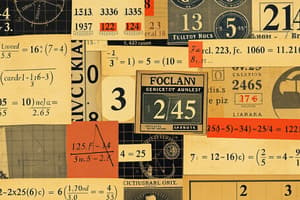Podcast
Questions and Answers
What is a significant limitation of the zero-one and normalized frequency encoding approaches?
What is a significant limitation of the zero-one and normalized frequency encoding approaches?
- They limit the vocabulary size significantly.
- They do not maintain the sequential order of words. (correct)
- They can only represent numerical data.
- They require extensive computational resources.
What do bigrams represent in text analysis?
What do bigrams represent in text analysis?
- Pairs of consecutive tokens treated as a single unit. (correct)
- Single words treated as separate units.
- Three consecutive words as a standalone vocabulary.
- Any sequence of tokens greater than three.
Which of the following is an example of a static feature that can add value to a text analysis model?
Which of the following is an example of a static feature that can add value to a text analysis model?
- Token frequency in an external database.
- Average length of words within the text. (correct)
- Use of synonyms to extend vocabulary.
- Sentiment analysis of the input text.
In the context of DNA analysis, what role does DNA serve?
In the context of DNA analysis, what role does DNA serve?
What is the first step in converting text sequences into a numerical representation?
What is the first step in converting text sequences into a numerical representation?
What do measures of complexity features correlate with?
What do measures of complexity features correlate with?
Why is it beneficial to order tokens in the vocabulary by frequency?
Why is it beneficial to order tokens in the vocabulary by frequency?
What does the bag-of-words approach result in when representing text documents?
What does the bag-of-words approach result in when representing text documents?
What must be ensured when mapping different lengths of text sequences in their numerical representations?
What must be ensured when mapping different lengths of text sequences in their numerical representations?
What is the purpose of encoding tokens numerically in the initial text?
What is the purpose of encoding tokens numerically in the initial text?
What is the role of mRNA in an organism?
What is the role of mRNA in an organism?
What is a k-mer in the context of computational biology?
What is a k-mer in the context of computational biology?
How can higher-order structures of proteins be represented?
How can higher-order structures of proteins be represented?
What defines a tree's structure in the context of graph encoding?
What defines a tree's structure in the context of graph encoding?
What can be inferred about the encoding of molecules using graphs?
What can be inferred about the encoding of molecules using graphs?
Flashcards
String
String
A continuous sequence of characters, often used to represent text or code. It's a fundamental data type in computer programming, allowing for the manipulation and storage of textual information.
Tokenization
Tokenization
The process of breaking down a sequence of text into individual words or meaningful units, called tokens. This step prepares text data for numerical representation and analysis.
Vocabulary
Vocabulary
A collection of all unique tokens that appear in a dataset. It acts as a dictionary for mapping words to their numerical representations.
Bag-of-Words
Bag-of-Words
Signup and view all the flashcards
Sequential Data
Sequential Data
Signup and view all the flashcards
DNA/RNA Sequence
DNA/RNA Sequence
Signup and view all the flashcards
k-mer
k-mer
Signup and view all the flashcards
Protein Primary Structure
Protein Primary Structure
Signup and view all the flashcards
Molecular Graphs
Molecular Graphs
Signup and view all the flashcards
Tree (in Graphs)
Tree (in Graphs)
Signup and view all the flashcards
Zero-One Encoding
Zero-One Encoding
Signup and view all the flashcards
Normalized Frequencies Encoding
Normalized Frequencies Encoding
Signup and view all the flashcards
N-grams
N-grams
Signup and view all the flashcards
Static Features
Static Features
Signup and view all the flashcards
DNA Sequence
DNA Sequence
Signup and view all the flashcards
Study Notes
Lecture 3 - Structured Inputs
- Lecture date and time: November 9, 2023, 10:05 AM
Part I - Designing Features
- Aim: Encode input objects (like text, images, DNA) into numerical values to distinguish them.
- Focus on features that highlight key differences between various objects.
- Objects with rich representations are ideal targets.
- Examples: text documents, images, DNA sequences, molecules.
- Importance is placed on converting sequences (like text or DNA) into understandable numerical formats.
1.1 Encoding Sequences
- Text Sequences:
- Computers do not interpret words as humans do.
- Therefore, numerical representation for words in text sequences is needed.
- Steps in conversion: Tokenization, Vocabulary Building, and Numerical Encoding of Texts.
- Tokenization: Splitting text into individual words (tokens).
- Build a vocabulary: Collecting all unique tokens (words) in the dataset.
- Numerical Encoding: Mapping each token to a unique index from the vocabulary in the initial text.
- Importance of Representations that preserve length: Lengths of text inputs vary, so representations must be the same dimension in feature space. Key is consistent dimensionality for the features.
- Various Different approaches for encoding texts includes:
- Bag-of-words (Each token is counted)
- Zero-one
- Normalized Frequency
1.2 Preserving Sequential Order
- N-grams: Methods that preserve consecutive tokens/words
- Bigrams: Consider pairs of consecutive words.
- Trigrams: Consider groups of three consecutive words.
- Static Features Include:
- Measurements of complexity: Avg characters/word, avg words/sentence (Correlate with readability).
- Other Features: Length (Length Features),lexicon counting (external words counts found frequently).
1.3 Encoding Graphs
- Represent each atom as a node.
- Connect atom-atom bounds using undirected edges.
- Maps bigrams to graphs by visualizing adjacent nodes.
- Graphs represent n-grams in generalized forms.
- Leads to combinations of node numbers that expand on consecutive n-grams.
1.4 Encoding Trees
- Special cases of graphs.
- Tree structure excludes cycles, creating unique advantages for encoding.
- Uses in Modeling: modeling internet conversations, where texts are already structured.
- Uses "prompt/response" pair features to further structure conversational exchanges which is useful.
- (e.g., In studies of online discussions)
1.5 Encoding Grids
- Grids/Images represented as 3-dimensional tensors.
- Pixels represented by vectors/values, often indicating RGB values.
- Image-patch analysis (neighbouring pixel blocks).
- Feature analysis: Applying filters and analyzing their results for relevant features can improve image analysis.
- mathematical treatment of images as flattened 3 dimensional tensors, allow for mathematical operations (e.g.inner products).
- Additional Features: edges/corners/other visual elements may be extracted for better image analysis
Studying That Suits You
Use AI to generate personalized quizzes and flashcards to suit your learning preferences.




